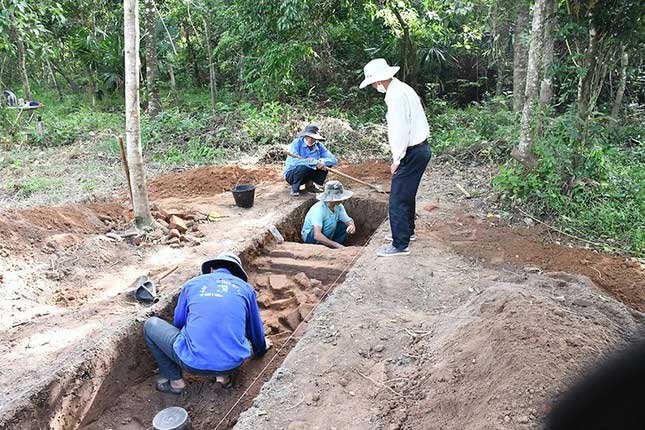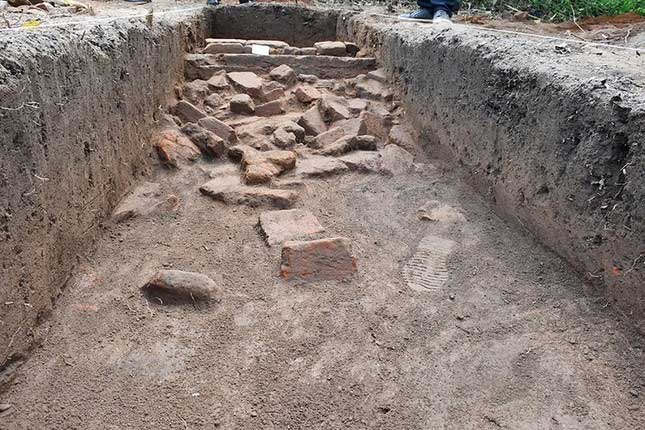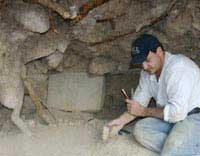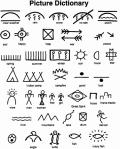An ancient road believed to be a mysterious path lying underground has been discovered for the first time at the My Son Sanctuary.
Recently, the My Son Cultural Heritage Management Board collaborated with a team from the Institute of Archaeology to explore and uncover a road beneath the ground, starting from the K Tower and leading into the center of the My Son Sanctuary (Quang Nam) in the 12th century. This is the first time that archaeologists and historians, both domestically and internationally, have become aware of this road.
The Mystery of the “Divine Path”

Remains of the wall recently uncovered underground. (Photo: MS).
During 30 days of work, the archaeological team excavated in two directions, east and west of the K Tower. The mysteries beneath the My Son heritage site are gradually being revealed, with a road connecting the K Tower to the main towers, which is hoped to be fully uncovered soon.
Specifically, in the eastern area of the K Tower gate, two exploratory pits were opened, initially revealing two remnants of walls on the north and south sides of the path running east-west. In the western area of the gate tower, three exploratory pits were opened, discovering remnants of the foundation of the path leading directly into the gate tower (K Tower).
The area around the K Tower, where the excavation was conducted, is dense with trees but has a relatively flat and open space. Although the road is now deeply buried, it can be seen that the surface of the road is flatter than the path currently used by visitors.
According to Dr. Nguyen Ngoc Quy, who led the excavation, this road could be the “Divine Path” – the pathway of Hindu deities, or the “Royal Road” – a path reserved for kings and Cham priests to enter and worship their deities, or it could be the road leading into the My Son Sanctuary (as it is known today).
Mr. Le Van Minh, head of the Conservation Department at the My Son Cultural Heritage Management Board, noted that the outer layer of the wall is more compact. It can be imagined that over many centuries, soil from above has flowed down, completely burying the outside before overflowing over the wall, continuing to cover the “Divine Path.”
“The extent of the road is still unknown, but the alignment shows it follows the flat land. If it continues in the direction just uncovered, this “Divine Path” goes straight into the central tower group,” Mr. Minh stated.
During the excavation process, the team from the Institute of Archaeology also discovered several fragments of items used for rituals, such as bowls, cups, and saucers. Besides the structure, these artifacts have significant value in shedding light on a part of history.
The wall of the road was constructed by laying bricks in double rows on both sides, with broken bricks packed in the middle. The wall has a large foundation that gradually narrows towards the top. The wall is quite low, perhaps to delineate the limits of the inner and outer spaces within the sacred area of the site.
A Road for Deities and Kings
According to Mr. Minh, the Cham people, influenced by Indian culture, had a society divided into classes. The My Son Sanctuary is a sacred space for these social strata. Therefore, this road is hypothesized to be reserved for the highest classes, while lower classes would take different paths.
“This could be the pilgrimage path of the ancient Cham people from the capital Tra Kieu to My Son. They would pass through the gate tower (K Tower) to enter. When we excavated, in addition to the wall of the “Divine Path,” the ground was also compacted, perhaps indicating a secondary path for lower classes,” Mr. Minh predicted.
Dr. Quy mentioned that the architectural remnants of this path have only been raised as an issue in recent years and were accurately identified during the recent exploration. The exploration team noted that this architecture has long been destroyed and buried under a thick layer of forest soil.

The archaeological team discovered the “Divine Path” beneath the My Son Sanctuary. (Photo: MS).
“The archaeological exploration has only been conducted in a very modest area, just 20m2, so it is not yet possible to clarify the specific dating of the site. However, through the relationship of the path’s ruins with the K Tower, it can be preliminarily assessed that the path dates back to the 12th century, corresponding to the dating of the K Tower,” Dr. Quy noted.
According to Dr. Quy, the results of the archaeological exploration around the K Tower have revealed remnants of architectural structures never before known in the history of the My Son site.
“Researching the archaeological system of the architectural remains of the path around the K Tower to clarify the presence of the “Royal Road” leading into the My Son Sanctuary of the ancient Cham people is a very necessary task. Completing this work will contribute new materials to provide a more comprehensive understanding of the cultural-historical-architectural space of My Son,” Dr. Quy expressed.
| We propose that the My Son Cultural Heritage Management Board submit to the Duy Xuyen District People’s Committee and relevant authorities for consideration and approval to continue the task of “Exploring and excavating the archaeological remains of the path to the east of the K Tower – My Son” in 2023; simultaneously agreeing to invest in the project “Archaeological excavation research of the path leading into the My Son Sanctuary” planned for implementation in the period 2024-2026, Dr. Nguyen Ngoc Quy stated. |





















































